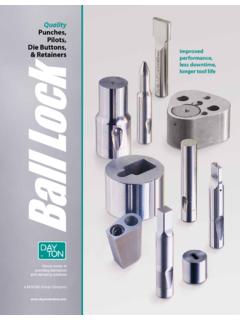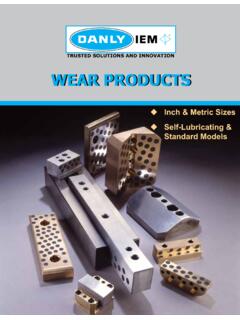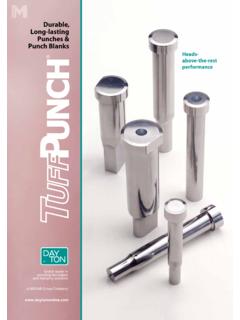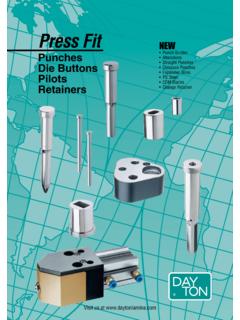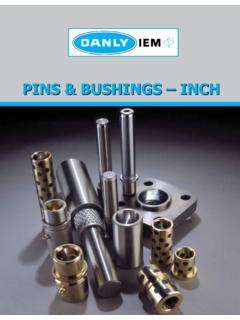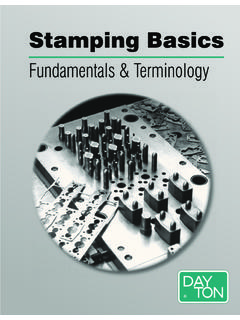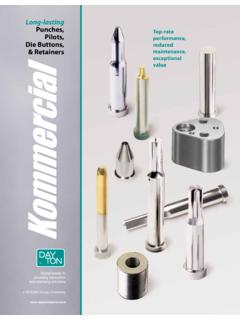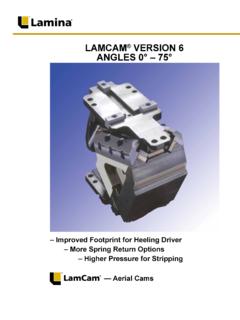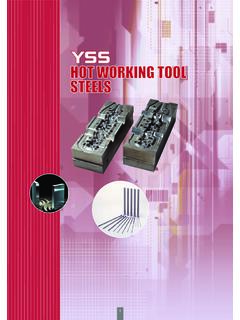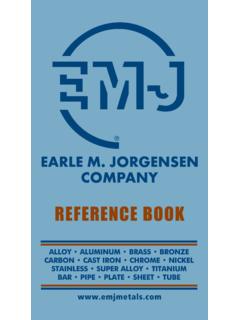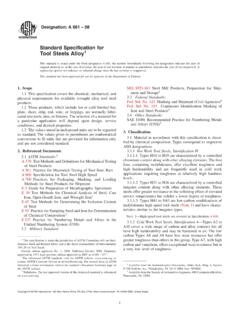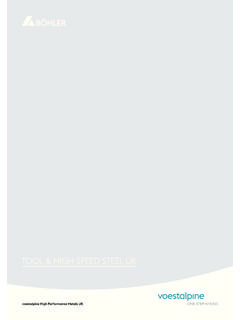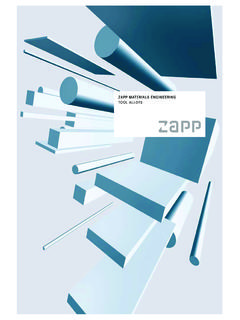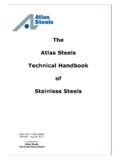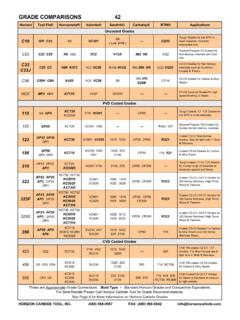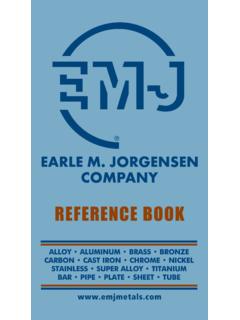Transcription of Tool Steels Heat Treating—Optimizing Tool Steel Properties
1 Global leader in providing fabrication and stamping solutionsDayton Progress Corporation 500 Progress Road Box 39 Dayton, OH 45449-0039 USAD ayton Progress Detroit 34488 Doreka Dr. Fraser, MI 48026 Dayton Progress Portland 1314 Meridian St. Portland, IN 47371 USA Dayton Progress Canada, Ltd. 861 Rowntree Dairy Road Woodbridge, Ontario L4L 5W3 Dayton Progress Mexico, S. de de Access II Number 5, Warehouse 9 Benito Juarez Industrial Park Quer taro, Qro. Mexico 76130 Dayton Progress, Ltd. G1 Holly Farm Business Park Honiley, Kenilworth Warwickshire CV8 1NP UKDayton Progress Corporation of Japan 2-7-35 Hashimotodai, Midori-Ku Sagamihara-Shi, Kanagawa-Ken 252-0132 JapanDayton Progress GmbH Adenauerallee 2 61440 Oberursel/TS, GermanyDayton Progress Perfuradores Lda Zona Industrial de Casal da Areia Lote 17 C s, 2460-392 Alcoba a, PortugalDayton Progress SAS 105 Avenue de l Epinette BP 128 Zone Industrielle 77107 Meaux Cedex.
2 FranceDayton Progress Czech sro Hala G Pra sk 707 CZ-294 71 Ben tky nad Jizerou Czech Republic a MISUMI Group CompanyHeat Treating Optimizing tool Steel PropertiesHeat treatment involves a number of processes that are used to alter the physical and mechanical Properties of the tool Steel . Heat treatment which includes both the heating and cooling of the material is an efficient method for manipulating the Properties of the Steel to achieve the desired vacuum furnace is used to heat the metals to very high tempera-tures and allow high consistency and low contamination in the pro-cess.
3 Each grade of tool Steel has specific heat treating guidelines that must be followed to acquire optimum results for a given ap-plication. Unlike cutting tools, the nature of the stamping operation places a high demand on tough-ness. Thus, a specific Steel grade used as a tool Steel for stamping must be heat treated differently than one used in a cutting Steel heat treatment process-es include: material segregation; fixturing; pre-heating; soaking; quenching; and tempering. The following procedures are gen-eral guidelines for tool Steel heat treatment. Certain Steels require different timing, preheating and soaking temperatures, and num-ber of tempers, , M2, PM-M4, & Segregation & Fix-turingSegregation by size is extremely important because different indi-vidual sizes require different rates in preheat, soak, and quench.
4 Fix-turing ensures even support and uniform exposure during heating and & SoakingDuring pre-heating, both cold-work & high speed tool Steels are evenly heated to prevent distortion and cracking. Soak-ing (austenitizing) is done for a specific time to force some of the alloy elements into the matrix of the is the sudden cooling of the parts from the austenitiz-ing temperature through the martensite transfer range. The Steel is transformed from austenite to martensite, resulting in hard-ened martensitic Steel is very hard, but too brittle for most applications. Tempering is heating the Steel to a lower-than-critical temperature to improve tough-ness.
5 tool Steels are typically tem-pered at temperatures between 400 - 1000 is a process that aids in transformation of austenite to martensite, ensuring greater hard-ness results and reduced internal stresses. This process takes place at temperatures between -150 and -310 F and will vary in dura-tion, depending on the size of the Vacuum Furnace1 The process starts by remov-ing the atmosphere creating a vacuum and electrically heat-ing the parts in the hot After the parts are properly heated (austenitized) the sys-tem is backfilled with nitrogen. Nitrogen is used as a means of conducting heat away from the parts.
6 A large turbine blower forces room temperature nitro-gen across the parts, cooling (quenching) them through the martensite transfer Hot nitrogen exits the hot zone through gates at the front and rear of the The nitrogen circulates through a heat exchanger where it is The cooled nitrogen is recircu-lated over the parts until they reach room maintains a state-of-the-art heat treatment facility, including support equipment and systems monitored by our in-house metallurgist. , Comparisons, & BenefitsTool SteelsForm 780 12/13a MISUMI Group CompanyHot Zone 1 Quench Nozzles 23 Exhaust GatesPartsHeat Exchanger 4 Turbine Blower 5780 tool 11/15/2014 12:30:50 PMChoosing tool Steels Balancing Toughness, Wear Resistance, & Compressive StrengthTool SteelsTool Steels refer to a variety of carbon and alloy Steels that are well-suited and widely used to make tools primarily used for perforating and fabrication.
7 tool Steels are made to a number of grades for different form-ing and fabrication applications. The most common scale used to identify various grades of Steel is the AISI-SAE addition, each grade of tool Steel has heat treatment guidelines that must be followed to achieve op-timum results. (The heat treating processes for stamping applications are different from those used for cut-ting tools.)This booklet presents basic infor-mation on tool Steel types (charac-teristics and features) and the heat treatment processes and Steel CharacteristicsTool Steels are very different from Steels used in consumer goods.
8 They are made on a smaller scale with stringent quality requirements, and are designed to perform in specific applications, such as machining or applications are made possible by adding a particular alloy along with the appropriate amount of carbon. The alloy combines with the carbon to enhance the Steel s wear, strength, or toughness charac-teristics. These alloys also contribute to the Steel s ability to resist thermal and mechanical chart shows some of the com-monly used tool Steels and their alloy EffectsEach alloy element shown in the chart below contributes to a specific characteristic in the finished Steel .
9 It can also create an undesirable side effect, particularly when used in excessive amounts. In addition, alloys can react with each other either enhancing or detracting from the desired 54 HRC QPopular hot work mold Steel QGood balance of toughness, heat check resistance, & high temp. strength QModerate wear resistanceS7 57 HRC QHigh impact resistance at relatively high hardness QVery high toughness to withstand chipping and breakingA2 62 HRC QGood toughness QModerate wear resistance QCombination of Properties and low cost make it well suited for a variety of tooling applicationsPM 1V 60 HRC QVery high impact toughness QHigh heat resistance QGood wear resistancePM 3V 60 HRC QHigh toughness QWear-resistant QMaximum resistance to breakage and chipping in a wear-resistant steelD2 61 HRC QHigh carbon.
10 High chromium QGood wear resistance QModerate toughnessM2 62 HRC QTungsten-molybdenum high speed Steel QVery good wear resistance QGood toughnessPM M4 (PS4) 62 HRC QExcellent wear resistance QHigh impact toughness QHigh transverse bend strengthPM 9V 56 HRC QGood toughness and wear resistance QResists cracking QNot for applications requiring high compressive strengthPM 10V (PS) 63 HRC QExtremely high wear resistance QRelatively high impact toughness QExcellent candidate to replace carbide in cold work tooling applicationsPM 15V 62 HRC QExceptional wear resistance, second only to carbide.
